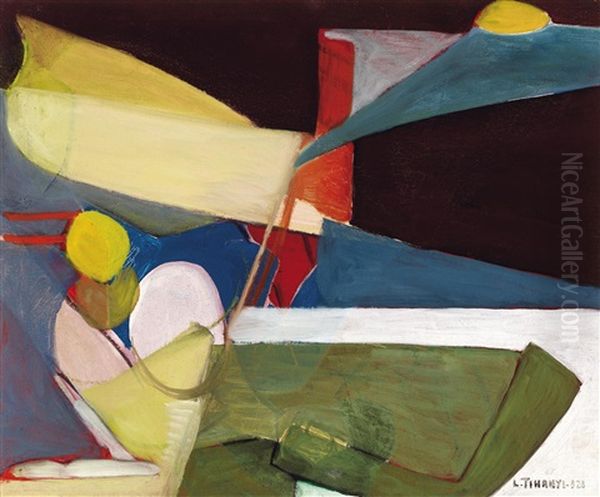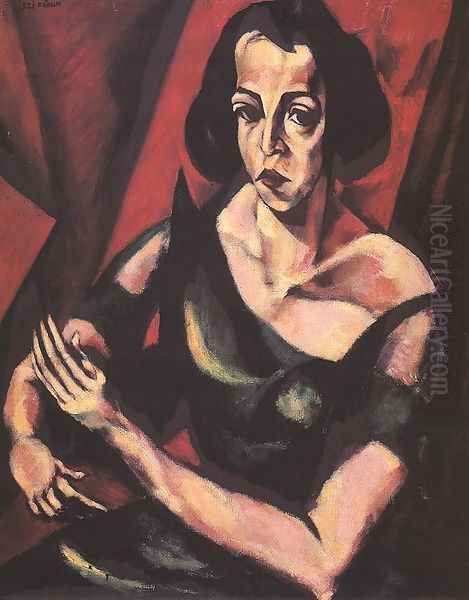Lajos Tihanyi (1885-1938) stands as a significant Hungarian painter whose artistic journey traversed the dynamic currents of early 20th-century European modernism. Renowned for his compelling portraiture and later forays into abstract art, Tihanyi's life and work reflect a period of intense artistic innovation and socio-political upheaval. His career, initiated in Budapest, blossomed amidst the avant-garde circles of Hungary and later found new dimensions in exile, particularly in Paris, the era's undisputed art capital.
Early Life and Artistic Awakening in Budapest
Born in Budapest in 1885, Lajos Tihanyi's formal artistic education commenced at the School of Arts and Crafts in Budapest, where he studied between 1904 and 1905. This period laid the foundational skills for his burgeoning talent. The artistic environment in Budapest at the turn of the century was vibrant, with artists keen to absorb and reinterpret the latest European trends, moving away from academic conservatism towards more expressive and modern forms of art.
Tihanyi quickly distinguished himself within this milieu. He was not merely a follower of trends but an active participant in shaping the Hungarian avant-garde. His early work began to show a distinct interest in bold color and expressive form, characteristics that would define much of his oeuvre.
The Eight (Nyolcak): Forging a Hungarian Avant-Garde
A crucial phase in Tihanyi's early career was his role as a founding member of the influential art group known as "The Eight" (Nyolcak). This group, active primarily between 1909 and 1912, was a cornerstone of Hungarian modern art. Its members, besides Tihanyi, included prominent artists such as Róbert Berény, Dezső Czigány, Béla Czóbel, Károly Kernstok, Ödön Márffy, Dezső Orbán, and Bertalan Pór. These artists shared a common goal: to introduce and champion modern artistic principles in Hungary, drawing inspiration from French Post-Impressionism, Fauvism, and the structural concerns of Paul Cézanne.

The Eight held their first exhibition, titled "New Pictures," in 1909, followed by a second exhibition under their group name in 1911. These shows were radical for their time in Hungary, challenging established artistic norms. Tihanyi's contributions to these exhibitions showcased his developing style, characterized by strong, often non-naturalistic colors, dynamic compositions, and a focus on capturing the essential character of his subjects, particularly in his portraits. His work from this period often displays Fauvist tendencies, akin to the explorations of French artists like Henri Matisse and André Derain, but with a unique Hungarian sensibility.
Exile: Vienna, Berlin, and the Path to Paris
The political landscape of Hungary underwent significant turmoil following World War I, culminating in the short-lived Hungarian Soviet Republic in 1919. Its subsequent fall led to a period of repression, prompting many intellectuals and artists, including Tihanyi, to leave the country. This marked the beginning of Tihanyi's life in exile.
He initially spent time in Vienna and Berlin, cities that were also vibrant centers of artistic activity. Vienna, with its legacy of Expressionism through figures like Egon Schiele and Oskar Kokoschka, and Berlin, a hub for Dadaism and the burgeoning Neue Sachlichkeit (New Objectivity), offered diverse artistic environments. While his stays in these cities were relatively brief, they undoubtedly exposed him to further modernist currents and connected him with other émigré artists. However, it was Paris that would become his permanent home and the primary stage for the next phase of his artistic development.
Paris: The Epicenter of Modernism
Tihanyi settled in Paris in 1923, a city teeming with artists from across the globe, including a significant community of Hungarian émigrés. Paris in the 1920s and 1930s was the undisputed capital of the art world, home to movements like Cubism (led by Pablo Picasso and Georges Braque), Surrealism, and the diverse abstract tendencies that were gaining momentum.
In Paris, Tihanyi continued to develop his artistic practice. He maintained connections with fellow Hungarian artists and writers, such as the photographer Brassaï (Gyula Halász) and the writer György Bölöni. These relationships provided a supportive network and intellectual exchange that was vital for émigré artists. His studio became a meeting place, fostering a sense of community far from their homeland.
Portraiture: Capturing the Psyche
Throughout his career, even as he explored abstraction, portraiture remained a significant genre for Lajos Tihanyi. His portraits are celebrated for their psychological depth and their ability to convey the personality and inner life of the sitter. He often painted intellectuals, writers, and fellow artists, capturing the vibrant cultural milieu of his time.

His approach to portraiture was far from conventional. Influenced by Post-Impressionism and Expressionism, and with an understanding of Cubist structural principles, Tihanyi used bold colors, assertive brushwork, and often slightly distorted forms to heighten the expressive power of his images. There's often a palpable tension or a subtle sense of irony in his characterizations.
One of his most notable early portraits is the Portrait of Magda Le Borde (1914). This work exemplifies his early mastery, with its rich coloration and sensitive rendering of the subject's presence. Another key work is the Portrait of Poet Lajos Kassák (1918). Kassák was a leading figure of the Hungarian avant-garde, a writer, artist, and editor who championed modernist ideals. Tihanyi’s portrait of him is a powerful depiction, using strong contours and a focused intensity to convey Kassák's intellectual force. These portraits are not mere likenesses; they are profound interpretations of character.
Embracing Abstraction: Abstraction-Création
While in Paris, Tihanyi's art gradually moved towards greater abstraction. This evolution was in line with broader trends in European art, where many artists were exploring non-representational forms of expression. A significant development in this regard was Tihanyi's involvement with the "Abstraction-Création" group.
Founded in Paris in 1931, Abstraction-Création was an international association of artists dedicated to promoting and exhibiting abstract art. It brought together a diverse range of artists working in various abstract styles, from geometric abstraction to more biomorphic and lyrical forms. Key members and associates included Jean Arp, Piet Mondrian, Wassily Kandinsky, Theo van Doesburg, Auguste Herbin, and Georges Vantongerloo. The group published a regular journal, also titled "Abstraction-Création," which served as a platform for theoretical discussions and the dissemination of abstract art.
Tihanyi became an important member of this group. His abstract works from this period often featured dynamic compositions of lines, shapes, and colors, sometimes retaining a hint of organic form or a sense of underlying structure derived from his earlier figurative work. He explored both semi-geometric and more organic abstract compositions, contributing to the rich tapestry of non-figurative art being developed at the time. His participation in Abstraction-Création solidified his place among the pioneers of abstract art, demonstrating his continued engagement with the cutting edge of artistic innovation. He was one of the few Hungarian artists directly involved in this influential movement, which sought to integrate rationality and visual logic into art, sometimes drawing parallels with scientific inquiry.
Artistic Style: A Synthesis of Influences
Lajos Tihanyi's artistic style is characterized by its dynamism, strong use of color, and a profound engagement with the human figure, even as he moved towards abstraction. His early works clearly show the influence of French Fauvism, with their arbitrary yet emotionally resonant color choices and energetic brushwork. The structural concerns of Post-Impressionism, particularly the legacy of Cézanne, are also evident in the way he constructed his compositions.
As his style matured, elements of Expressionism became more pronounced, especially in the psychological intensity of his portraits. There's a keen observation of human character, often imbued with a sense of introspection or underlying tension. Some art historians also note a subtle assimilation of Analytical Cubism's principles in the way he fragmented and reconstructed forms, particularly in his portraits from the late 1910s and early 1920s, lending them a faceted, sculptural quality. Artists like Chaïm Soutine, another émigré in Paris known for his intensely expressive portraits, worked in a similar psychological vein, though their stylistic approaches differed. Tihanyi’s work, however, often maintained a greater degree of structural clarity.
His later abstract works, developed during his association with Abstraction-Création, demonstrate a shift towards non-representational concerns, focusing on the interplay of form, color, and line to create compositions that were autonomous and self-referential, yet often retained an organic or dynamic quality that linked back to his earlier expressive tendencies.
Friendships and Intellectual Circles
Beyond formal art groups, Tihanyi's life was enriched by a network of friendships with artists and intellectuals. In Budapest, his association with "The Eight" placed him at the center of avant-garde discourse. His friendships with figures like Róbert Berény and Béla Czóbel were formative.
In Paris, this network expanded. He was close to the photographer Brassaï, who famously documented Parisian life, and the writer and art critic György Bölöni. He also maintained connections with literary figures like Andor Halasi. These relationships were not merely social; they involved a deep intellectual and artistic camaraderie, crucial for artists living in exile and navigating the complex Parisian art scene. These circles provided stimulus, support, and a continued connection to Hungarian culture, even as they embraced the internationalism of Paris. The exchange of ideas within these groups undoubtedly influenced his artistic thinking and development.
Legacy and Enduring Influence
Lajos Tihanyi passed away in Paris in 1938, never having returned to Hungary after his departure in 1919. Despite the challenges of exile and the interruptions to his career, he left behind a significant body of work that attests to his talent and his important role in modern art.
His paintings are held in numerous prestigious collections, including the Hungarian National Gallery in Budapest, which houses a substantial collection of his works, reflecting his importance to his native country's art history. Internationally, his art can be found in institutions such as the Musée d'Art Moderne de Paris and the Brooklyn Museum in New York, among others. His works have been featured in various exhibitions dedicated to Hungarian avant-garde art and European modernism, ensuring his continued recognition.
Tihanyi's legacy lies in his powerful synthesis of major early 20th-century art movements, his psychologically astute portraiture, and his contribution to the development of abstract art. He was a bridge figure, connecting the artistic innovations of Hungary with the broader European avant-garde. His commitment to modernism, his bold use of color, and the expressive depth of his work continue to resonate with audiences and art historians today. He remains a testament to the resilience of artistic creation in the face of personal and political adversity, and a key figure for understanding the international character of modern art in the first half of the 20th century. His journey from the vibrant art scene of Budapest, through the crucible of "The Eight," to the cosmopolitan hub of Paris, and his engagement with Abstraction-Création, marks him as a truly European artist of his time.